Dee Estuary Birding
Monthly Newsletter...
August 2023 Newsletter

Wetland Bird Survey Annual Report
2021/22
Summary and Highlights
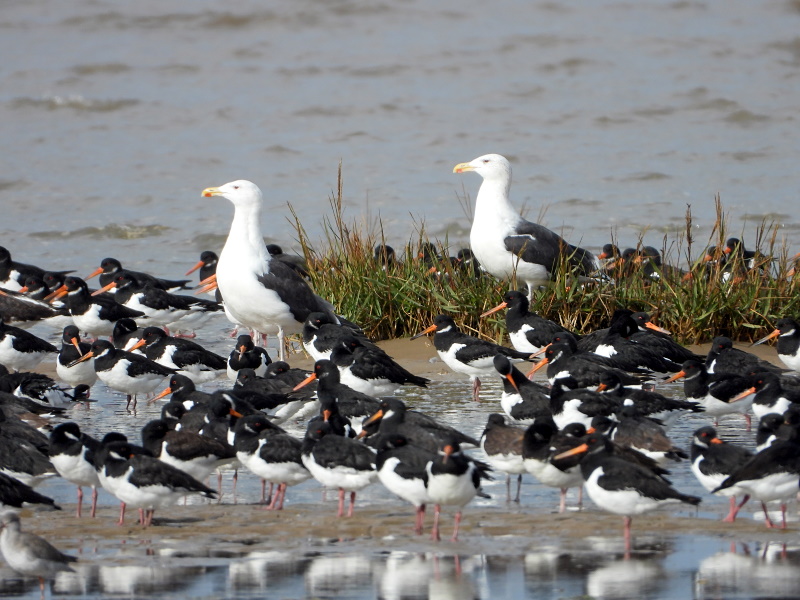
Both the local Dee Estuary and National WeBS Reports
for 2021/22 have recently been published and here I delve into the data
in order to pull out some interesting facts and figures relevant to the
Dee Estuary.
There are two aspects to the national report, there
is a 'Summary Report' which contains a lot of interesting articles and
highlights, some of which I will mention below. The second is the
actual
numbers and trends where you can list the data for species and sites -
this
has been updated for 2021/22 and the
counts for most species go all the way back to 1970. You can access all
this and more from the BTO WeBS page:
https://www.bto.org/our-science/projects/wetland-bird-survey/publications/webs-annual-report
Mega sites

On page 14 of the Summary Report there is an article
titled 'Largest
waterbird aggregations' which includes a map of the most important
sites in the UK. This is shown above with my annotation of 'mega
sites'. The Wash is rightly recognised as the most important site in
the country but if you look at the map there are two mega sites both of
equal importance - and each holding a peak of around 700,000 birds
according to the Report.
The Dee Estuary is, of course, a key site on the west coast and part of
the Mega Site on the Liverpool Bay coast, there is an
almost unbroken shoreline from here to the north shore of Morecambe Bay
and the Duddon Estuary. That number of 700,000 is the sum of the peak
counts for all species - the actual
number of birds present at any one time will usually be quite a lot
lower, but
how many individual birds actually pass through our estuaries in any
one year? That's impossible to say but with a high turnover during the
months of migration it is going to be a lot higher than that 'peak'
count of 700,000.
But to put those two mega sites in the UK into perspective, according
to the
Natural World Heritage website
(http://world-heritage-datasheets.unep-wcmc.org/datasheet/output/site/the-wadden-sea)
the Wadden Sea, over in the Netherlands, can hold up to six million
birds at any one time. Wow!
Wildfowl
On page 22 of the Summary Report there is an article called 'Whooper Swans
on the Rise'. The first sentence I found particularly interesting
"Whooper
Swans undertake what is probably the longest sea crossing of any swan
species as they travel to winter in the UK and Ireland from their
Icelandic breeding grounds". Numbers have risen rapidly nationally
with a 244% increase in the last 25 years. On the Dee Estuary we saw a
sharp increase from just five in 2002 to 86 in February 2011. Since
then numbers have slowly decreased but 55, in March 2022, was the third
highest count here. This is in stark contrast to Bewick's Swans
which are now a rare bird on the Dee Estuary with just three counted on
Shotwick Fields in January 2022. In 2001 we had 118 here, this trend is
similar to the national picture with birds tending to spend the winter
further east and also an overall fall in numbers internationally.
Our area is incredibly important for Shelducks with, in most years, the Dee and Mersey Estuaries being the top two sites in the country. 2021/22 was different as the Humber Estuary had large numbers moulting in July 2021 with a count of 13,012, about double their previous record. This compares with 13,704 moulting on the Mersey Estuary, also in July, and 8,708 on the Dee Estuary in October 2021. It was good to see the return of large numbers on the Mersey and this was the highest count there since July 2006. Incidentally, feathers collected for Ross Green's PhD study (Ref 3) has recently confirmed (but long suspected) that the Dee Estuary is also a moulting site for Shelduck, and in 2021 there were 5,088 present in July - thus making a massive total of 18,793 moulting on our two local estuaries.
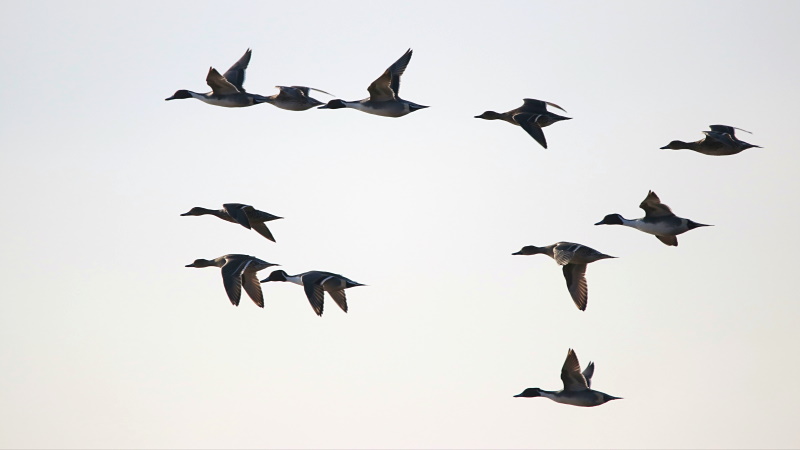
2021/22 was also good for other species of duck. The Dee Estuary
remains the most important site in the country for Pintail
with a good count of 5,955 in November 2021, above the five year mean
of 5,442. There has been a recent increase on the Dee after a low count
of 2,729 in 2013/14. Although there was a slight fall in Wigeon
numbers compared with 2020/21 there was still a good count of 7,199.
There has been a sharp increase in the five year average for Wigeon in
recent
years, from 2,299 in 2011/12 to the current value of 7,614. It's a
similar story with Teal with
an increase from 2,299 in 2007 to the latest count of 7,028 in 2021/22.
The Dee Estuary had the third highest Teal count in the country in
2021/22,
behind the Somerset Levels, with 7,920, and the Humber Estuary with
9,994.
Waders
In the Summary Report there are articles about Black-tailed Godwits and
Redshanks, and the Dee Estuary is very important for both these
species. The Dee Estuary had the highest count in the country for Black-tailed Godwits
with 7,780 in September 2021, largely thanks to a massive 5,530
moulting in the Caldy Wildfowl Collection (my count!). Nationally it is
a story of a very sharp increase since the 1980s, with some signs of a
plateauing out in the last six years or so.
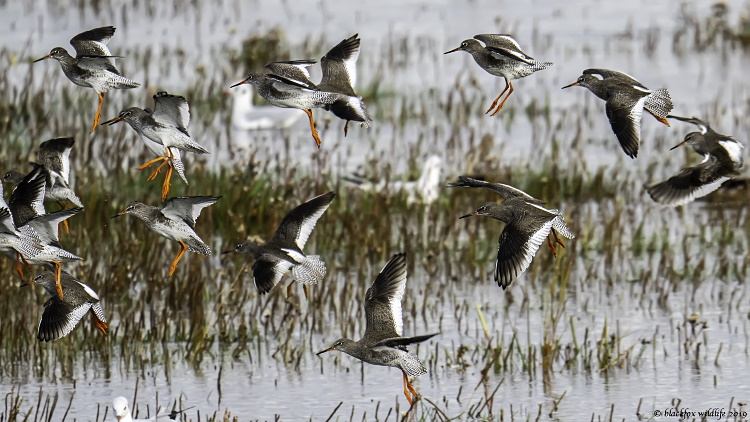
The Dee Estuary is the most important site in the
country for Redshank and there
was a peak 10,302 in September 2021, close to the five year average for
most of this century.
It's good to see large numbers Oystercatchers
back on the estuary with a peak count of 32,051 in September 2021, with
high numbers through to January when there was a count of 30,362. At
the end of the last century numbers were less than half that due to
rampant over-cockling - the 2008 Dee Estuary Cockling Order has made a
huge difference and something all estuaries should incorporate in their
management plan. The Dee Estuary is the second most important site for
Oystercatchers, behind Morecambe Bay.
So overall a good year for the Dee Estuary. There is
much more of interest in the Summary Report and data which I haven't
mentioned but I'll let you find that yourselves. This includes an
article about Knots (page 30), I'll be referring to this in an article
I'm writing about this species which I hope will be ready for next
month's newsletter.
1. Graham E. Austin, Neil A. Calbrade, Gillian A. Birtles, Kirsi Peck, Simon R. Wotton, Jessica M. Shaw, Dawn E. Balmer and Teresa M. Frost. 2023. Waterbirds in the UK 2021/22: The Wetland Bird Survey and Goose & Swan Monitoring Programme. BTO, RSPB, JNCC and NatureScot. British Trust for Ornithology, Thetford.
2. Neil Friswell and Colin Wells, Dee Estuary and North Wirral Foreshore WeBS Annual Report, 2021/2022.
3. Ros Green, Feather Findings, BTO News 347, Summer
2023. Find out more about Ros Green's PhD research on Shelducks here: shelducks.co.uk.
Richard Smith
Colour Ring Report
There have been plenty of colour ringed birds to record over the past
few weeks, but we start off with what sounds like a fascinating new
project.
Rock Pipit Colour Ringing Project - Hilbre

Rock Pipits are fairly common on Hilbre in winter and over the last few
years we've had a small breeding population Many of these birds have
been ringed but the problem is they have to get recaught by a ringer to
get any subsequent data on survival or site fidelity. To make birds
more identifiable in the field we've registered and got permission to
start a project fitting individually lettered darvic rings to the right
leg. Hopefully these will be more easily read in the field and provide
more data to help us understand the population dynamics of this species
on the island.
The small breeding population is supplemented by passage birds
from Scandinavia during the spring and autumn. We have previously
controlled a Norwegian darvic marked Rock Pipit. We have long suspected
that some of our passage birds are of the Scandinavian race
‘littoralis’ and this control bears this out.
Scandinavian Rock Pipits are a feature of the Dee
estuary during the
winter but we don't know if some of these birds are using Hilbre as a
staging post or whether it is a separate wintering population with no
interchange. Hopefully we can answer these questions and a a few more.
The aims of the project are to:
- Study adult survival rates and site fidelity of the resident population.
- Monitor the breeding population due to increased visitor footfall to the island.
- Dispersal of fledged young of the resident population.
- Find out if our population shows site fidelity.
- Determine origin of spring and autumn migrants and what proportion of these over winter on Hilbre and what proportion use the island as a staging post.
- Whether there is any interchange between birds that winter on the mainland with those on Hilbre.
At the time of writing two birds have already been
colour ringed and
and one (CAB) has already been re-sighted in the field on Hilbre with
the ring read at close ranges using binoculars.
Please report all sightings to secretary@hilbrebirdobs.org.uk.
Phil Woollen (Hilbre Bird Observatory) - https://wirralbirders.blogspot.com/
Little Egrets

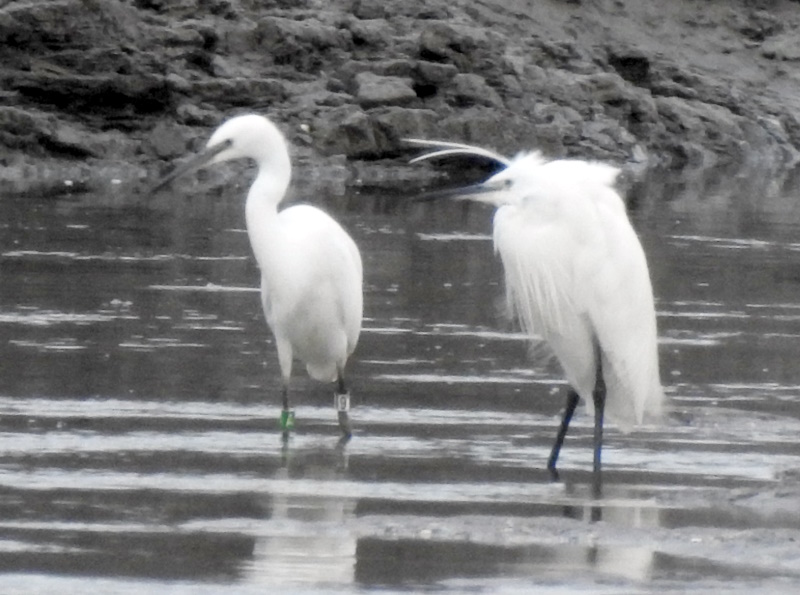
The
Merseyside Ringing Group have been busy at Hale Duck Decoy colour
ringing a total of 60 Little Egret chicks in late May and early June.
So far we've seen five of them at Heswall including the two
photographed above. One of the chicks
they ringed in late May was recorded in the Netherlands on July 23rd, a
good journey for such a young bird.
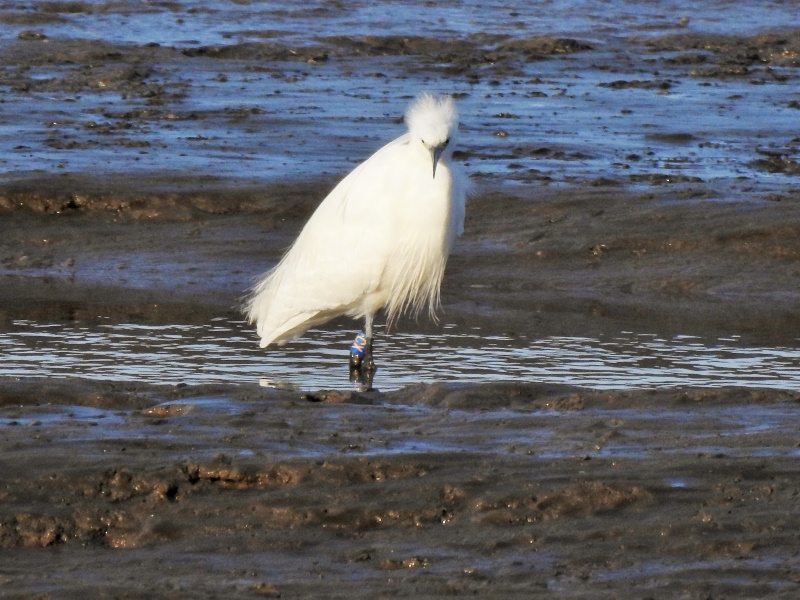
Blue (CX)
Ringed at Newark-on-Trent, Notts, in May 2017.
Recorded at Rutland Water in August 2017, and then:
First record at Heswall was in September 2019, and it's been seen here
every year since and always from July to mid-September, including
26/07/2023.
Apart from the record at Rutland Water the year it was ringed it has
never been seen away from Heswall. It is likely it breeds nearby then
moves elsewhere for the winter.
Black-tailed Godwits
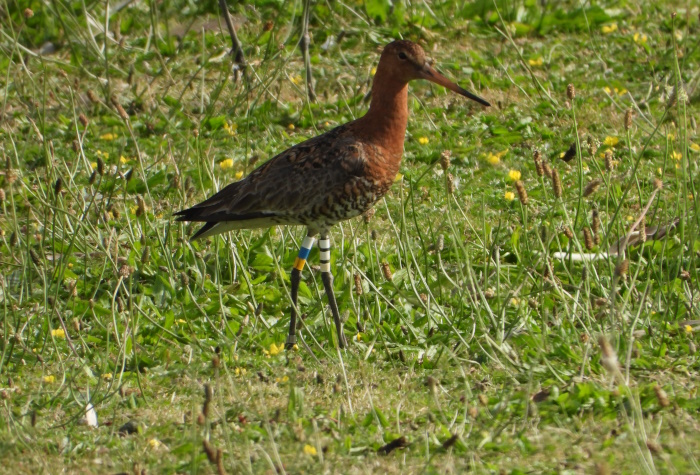
WBY-W=
Ringed at Lough Beg, Cork Harbour, on 12/09/2021.
Recorded at Caldy Wildfowl Collection on 06/07/2023, no other records.
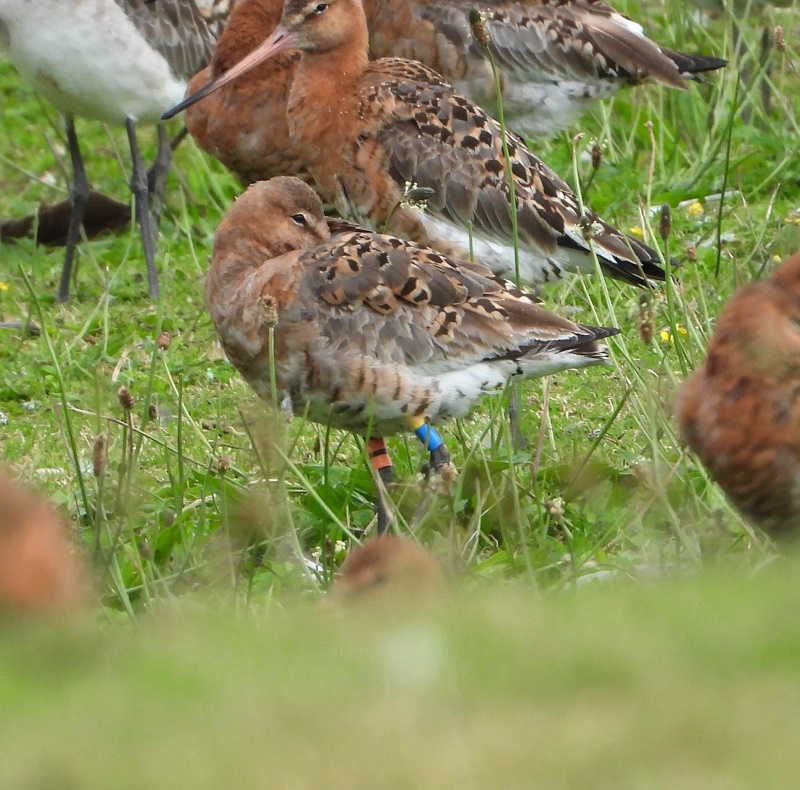
YB-O=
Ringed at Belfast Harbour Reserve RSPB on 21/04/2021.
Recorded in Belfast Lough in September 2021.
It was at Caldy Wildfowl Collection on several dates in the second half
of July 2023.

RW-GZ and GY-WZ
were both ringed as breeding adults in the south of Iceland in 2023.
Both of these birds were recorded on several dates at Caldy Wildfowl
collection in the second half of July 2023.
Mediterranean Gull
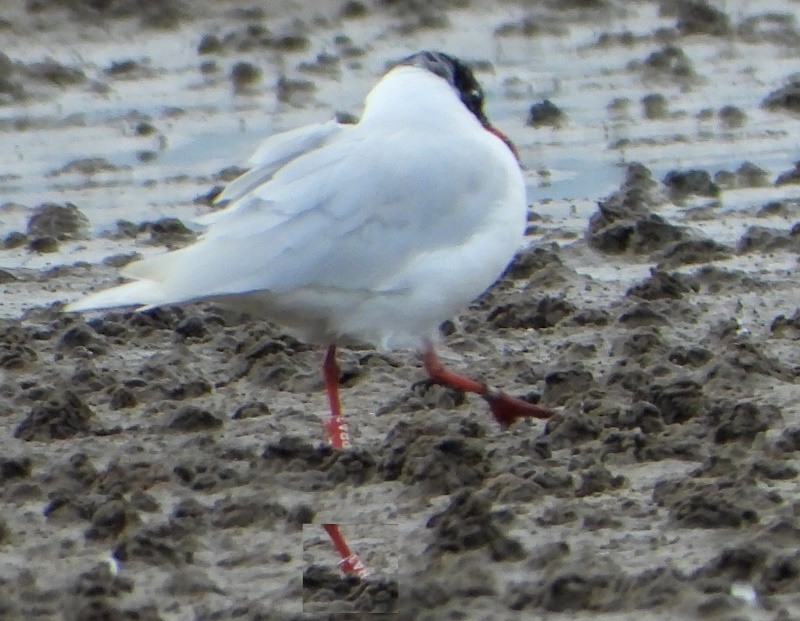
Red - PRA3.
Ringed in SW Poland on 05/06/2017, as a chick.
Recorded:
SW Poland on 27/04/2019.
Grimley Camp Lane Pits, NW of Worcester, on 28/07/2019.
Hoylake on 01/08/2019.
Mimizan (SW of Bordeaux) on the Atlantic coast of France on 21/11/2019.
Thurstaston Shore on 28/07/2023.
I was one of three people to see this Polish ringed
Mediterranean Gull at Hoylake on Aug 1st 2019 so it was a nice surprise
to catch up with it again at Thurstaston in July.
Black-headed Gull

Red - 2JJ9
Ringed at Blackness Castle on the south shore of the inner Firth of
Forth on 24/11/2021, as a 2nd year bird.
Recorded:
Queen Anne School, Dunfermline, on 10/12/2021.
Kirkcaldy promenade, Fife, on 26/01/2022.
West Kirby shore on 29/06/2023.
Sandwich Terns
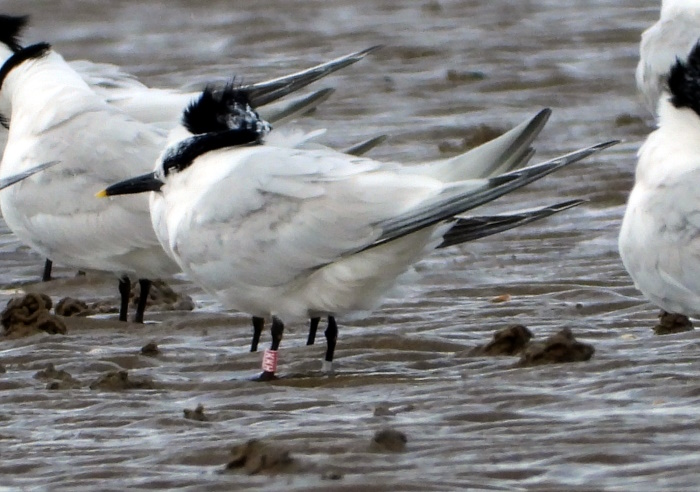
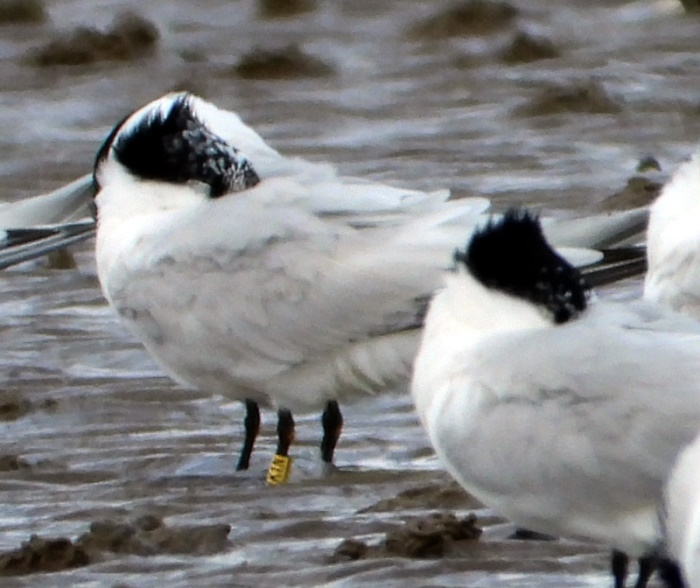
Because of bird flu no Sandwich Tern chicks were
ringed this year, but 16 colour ringed adults during July was a good
total. All recorded at West Kirby and Hilbre.
Nine were ringed at Wexford in SE Ireland, three at
Ynyslas (Cardigan Bay), two at Hodbarrrow, Cumbria, and one in Northern
Ireland.

Yellow KJC was twice recorded by Tony Ormond at West
Kirby at the end of July, and I had it at Cemlyn Bay (photo above) in
2021. In April this year it was recorded
at Agadir, Morocco. Considering that all our Sandwich Terns pass down
the Moroccan coast I was surprised when I realised that this was the
first record from there for any of our terns.
Photographic Guide to Colour-marked Red Knot
To mark the return of the Knot from Canada Rose
Maciewicz and Peter Knight have updated their 'Photographic Guide to
Colour-marked Red Knot' - download the PDF file by clicking here.
Colour Rings were recorded by Richard Smith, Steve Hinde, Colin Schofield, Alex Jones, Tony Ormond, Alan Hitchmough and Phil Woollen.
Richard Smith
July Bird News
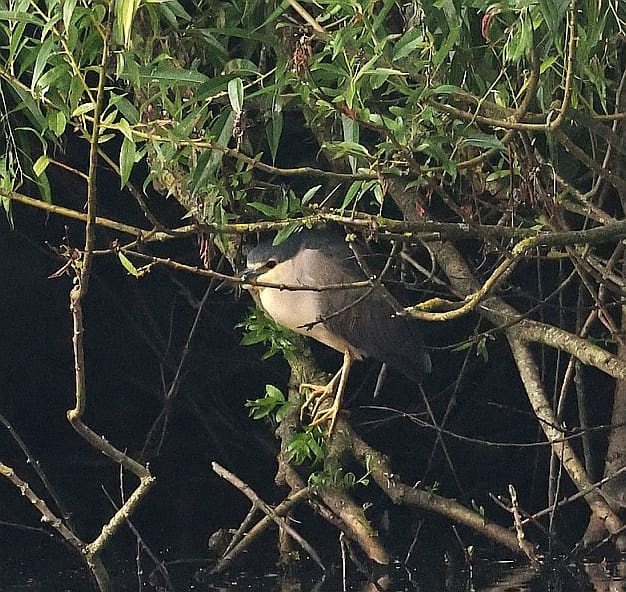
It was a good month at Burton Mere Wetlands with a
Night Heron on the Meres on the 4th and a male Spotted Crake seen right
at the end of the month in the reeds. Marsh Harriers were showing well
all month with up to
six in the air together, and on the 27th a ringtail Hen Harrier turned
up. Two Garganeys were present towards the month-end and waders
included four Little Ringed Plovers and a Wood Sandpiper. Another
notable rarity was a brief view of a Red-backed Shrike in Talacre dunes
on the 13th.
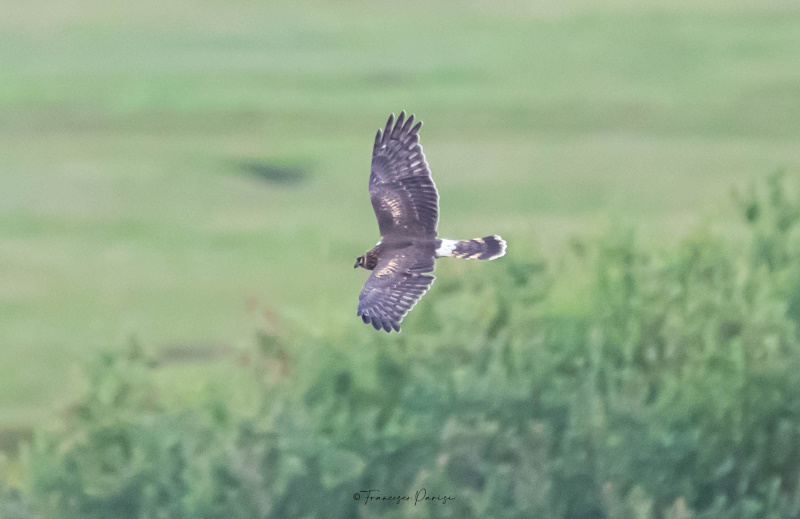
Other raptors included two records each of Osprey
and Red Kite. Waders returned in good numbers including 2,600 Redshanks
at Heswall by the 27th, but it was at the Caldy Wildfowl Collection
where we had the spectacular sight of 4,500 Black-tailed Godwits with
most in full breeding plumage. This small field (as it happens a short
walk from my house) is one of the most important sites in the country
for this species at this time of year when they are moulting.
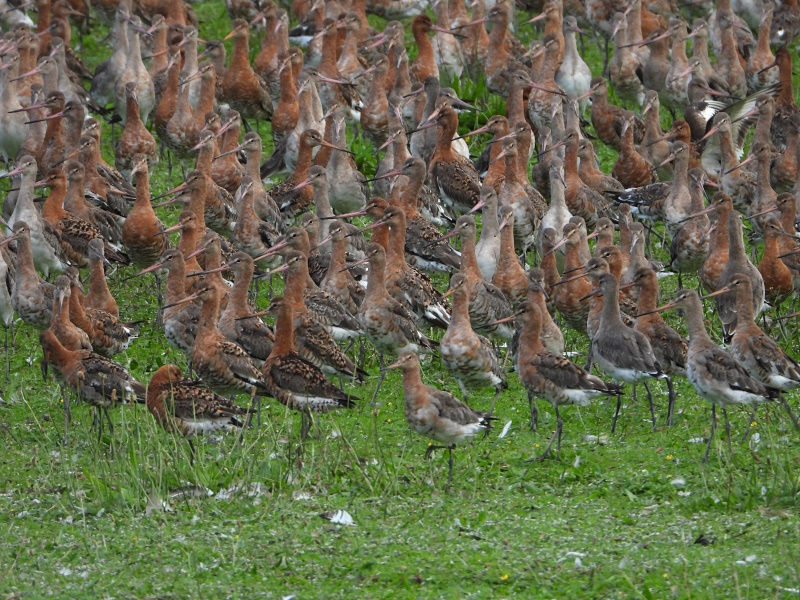
It's always good to see and hear the Sandwich Terns
at this time of the year, numbers had increased to at least 350 at West
Kirby for high tide by the month-end. Numbers of Mediterranean Gulls
seem to increase every year and a remarkable 17 were at
Heswall/Thurstaston on the 19th.
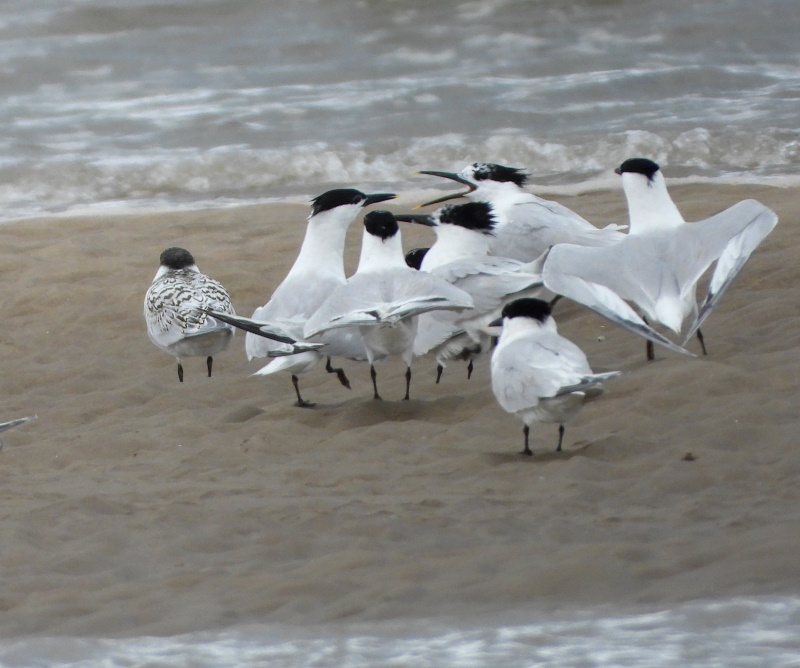
Strong winds on the 2nd blew in two Storm Petrels and 12 Manx
Shearwaters to Leasowe Gunsite whilst at the end of the month 6 Arctic
Skuas flew past Hilbre, a Black Guillemot was at Hilbre on the 30th.
There was one other seabird out there in Liverpool
Bay in July - a Black-browed Albatross! It was seen from a boat south
east of Gwyn-Y-Mor windfarm on the 10th, we think somewhere off
Prestatyn and Rhyl. It's quite possible this bird was visible from
Gronant at one point if anybody had been looking, but that's just pure
speculation! Anyway, an intriguing record. Prior to this I think the
nearest Black-browed Albatross to the Dee Estuary was off Bardsey
Island a few years ago.
What to expect in August
There will be a lot of birds moving this month,
particularly waders - adults and, hopefully, plenty of young
birds with them. At Hoylake and across at Point of Ayr and Gronant the
shore will
be full of Dunlins and Ringed Plovers, towards the end of the month we
usually get a few Little Stints and the first of a passage of juvenile
Curlew Sandpipers. Look out also for Knots, Grey
Plovers and Bar-tailed Godwits still in their breeding plumage.
A small but steady passage of Greenshanks will be
coming through Parkgate, Burton Mere Wetlands and Connah's Quay, whilst
at Thurstaston will be over four thousand Reshank. There should be well
over 5,000 Black-tailed godwits at the Caldy Wildfowl Collection and on
the mud and rocks at the south end of West Kirby Marine Lake a nice
flock of over 100 Turnstones still in full summer plumage will show
well, with plenty more across at Hilbre.
On the marshes look out for Spoonbills and Great Egrets, and one or two returning Hen Harriers and Short-eared Owls.
If we get gales then August is a good month for spotting Manx Shearwaters and a selection of skuas, a north-west gale at the end of the month could even produce one or two Leach's Petrels.
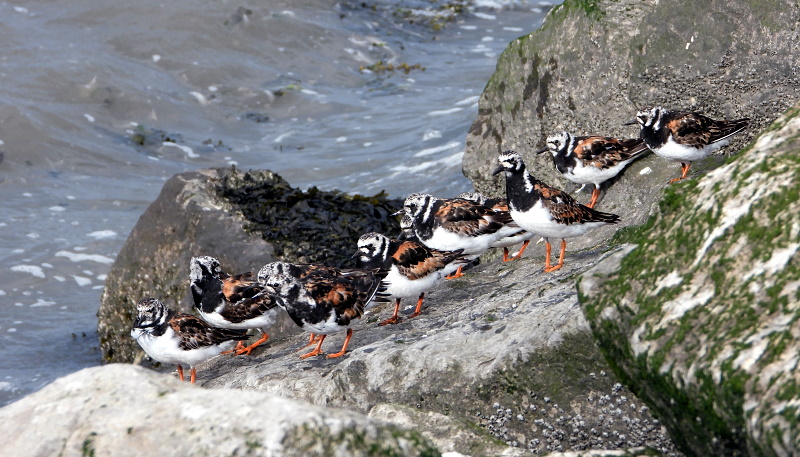
Forthcoming Events
August Highest Spring Tides (Liverpool)
Also see Tides page.
3rd August, 13.12hrs (BST), 9.6m.
4th August, 13.58hrs (BST), 9.6m.
31st August, 12.09hrs (BST), 9.6m.
Forthcoming Events
Also see events at https://events.rspb.org.uk/deeestuary